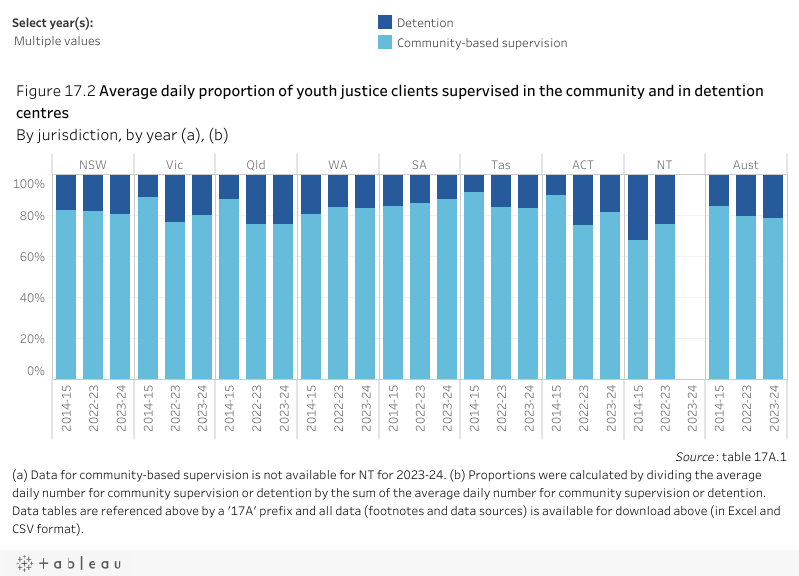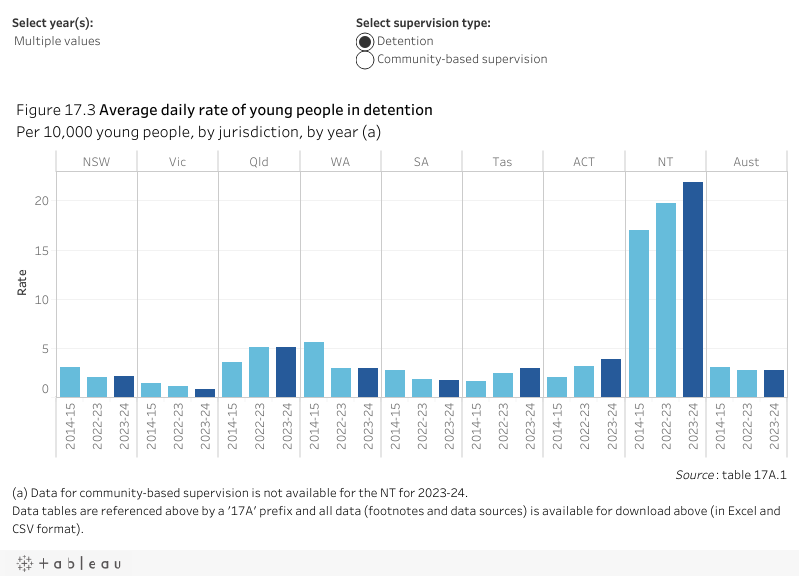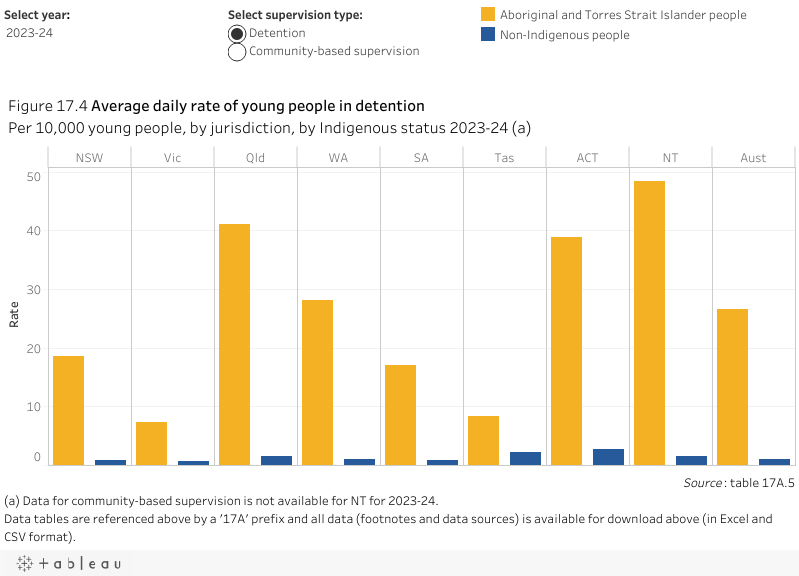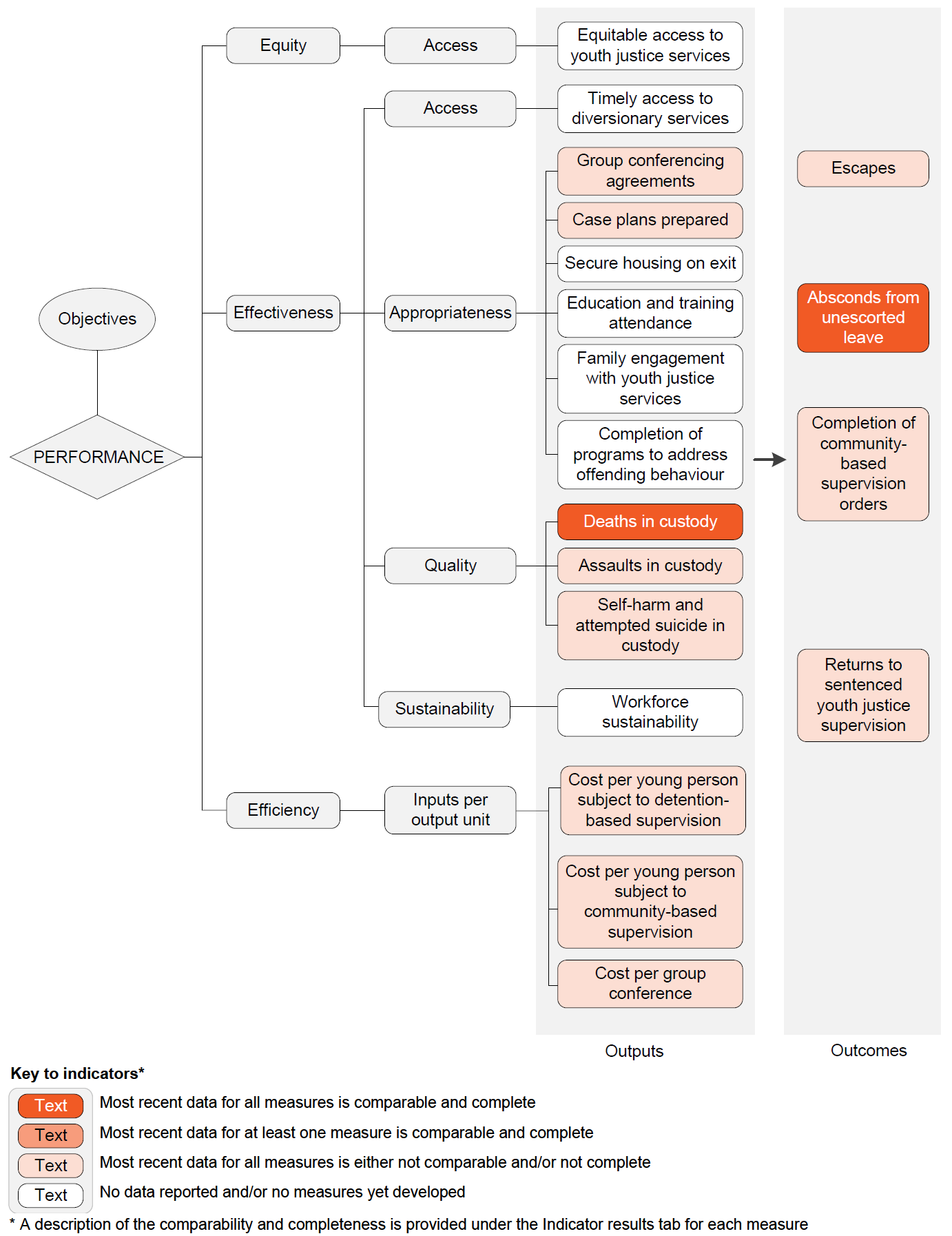WORKING GROUP DRAFT – IN CONFIDENCEReport on Government Services 2026
PART F, SECTION 17: RELEASED ON 29 JANUARY 2026
17 Youth justice services
This section reports on the performance of governments in providing youth justice services.
The Indicator results tab uses data from the data tables to provide information on the performance for each indicator in the Indicator framework. The same data is also available in CSV format.
Data downloads
![]() 17 Youth justice services data tables (XLSX 410.7 KB)
17 Youth justice services data tables (XLSX 410.7 KB)
![]() 17 Youth justice services dataset (CSV 771.1 KB)
17 Youth justice services dataset (CSV 771.1 KB)
Refer to the corresponding table number in the data tables for detailed definitions, caveats, footnotes and data source(s).
Objectives for youth justice services
Youth justice services aim to promote community safety, rehabilitate and reintegrate young people who offend, and contribute to a reduction in youth re-offending.
To achieve these aims, governments seek to provide youth justice services that:
- divert young people who offend from further progression into the youth justice system to alternative services
- assist young people who offend to address their offending behaviour
- provide a safe and secure environment for the protection of young people during their time in detention
- assist young people who are in youth justice detention to return to the community
- promote the importance of the families and communities of young people who offend, particularly Aboriginal and Torres Strait Islander communities, in the provision of services and programs
- support young people to understand the impact of their offending on others, including victims and the wider community
- recognise the rights of victims
- are delivered sustainably.
Governments aim for youth justice services to meet these objectives in an equitable and efficient manner.
Youth justice systems are responsible for administering justice to those who have committed or allegedly committed an offence while considered by law to be a child or young person.
The youth justice system in each state and territory comprises:
- police, who are usually a young person’s first point of contact with the system, and are typically responsible for administering the options available for diverting young people from further involvement in the youth justice system (section 6)
- courts (usually a special children’s or youth court), where matters relating to the charges against young people are heard. The courts are largely responsible for decisions regarding bail, remand and sentencing (section 7)
- statutory youth justice agencies, which are responsible for the supervision and case management of young people on a range of legal and administrative orders, and for the provision of a wide range of services intended to reduce and prevent crime
- non-government and community service providers, who may work with youth justice agencies to provide services and programs for young people under supervision.
This section reports on services provided by statutory youth justice agencies that are responsible for the supervision and case management of young people who have committed or allegedly committed an offence; in particular, community‑based supervision, detention‑based supervision and group conferencing (refer to the ‘Explanatory material’ tab for definitions).
‘Young people/person’
For the purposes of this section, young people/person is defined as people who are aged between the minimum age of criminal responsibility (MACR) in the relevant state or territory legislation and 17 years old (unless otherwise specified). In 2023, the Australian Capital Territory and the Northern Territory increased the MACR to 12 years old. In 2024, the Northern Territory changed the MACR to 10 years old.
Therefore, from 2024-25, young people/person refers to youth aged 12–17 years in the Australian Capital Territory, and youth aged 10–17 years in the remaining jurisdictions.
To enable comparability across jurisdictions, the total youth population estimates (refer to tables 17A.27–28) used to calculate rates per 10,000 young people, have been adjusted to align with the definition of young people/person in the relevant state or territory. The total youth population estimates are young people aged 12–17 years for the Australian Capital Territory and young people aged 10–17 years for all remaining jurisdictions. The Australian totals are the sum of the population estimates for young people aged 12–17 years for the Australian Capital Territory and young people aged 10–17 years for the remaining jurisdictions for 2024-25 (table 17.1).
| Financial year | Definition of young people | Population estimates |
|---|---|---|
| 2015-16 to 2016-17 | Qld: 10–16 years All remaining jurisdictions: 10–17 years | All jurisdictions and Australian totals: population estimates for young people aged 10–17 years |
| 2017-18 | Qld: 10–16 years until February 2018 All remaining jurisdictions: 10–17 years | All jurisdictions and Australian totals: population estimates for young people aged 10–17 years |
| 2018-19 to 2022-23 | All jurisdictions: 10–17 years | All jurisdictions and Australian totals: population estimates for young people aged 10–17 years |
| 2023-24 | ACT and NT: 12–17 years All remaining jurisdictions: 10–17 years | ACT and NT: population estimates for young people aged 12–17 years All remaining jurisdictions: population estimates for young people aged 10–17 years Australian totals: sum of the population estimates for young people aged 12–17 years for the ACT and NT and young people aged 10–17 years for the remaining jurisdictions |
| 2024-25 | ACT: 12–17 years All remaining jurisdictions: 10–17 years | ACT: population estimates for young people aged 12–17 years All remaining jurisdictions: population estimates for young people aged 10–17 years Australian totals: sum of the population estimates for young people aged 12–17 years for the ACT and young people aged 10–17 years for the remaining jurisdictions |
State and territory governments have responsibility for funding and/or providing youth justice services in Australia. Each jurisdiction has its own legislation that determines the policies and practices of its youth justice system and while this legislation varies in detail, its intent is similar across jurisdictions.
Legislation in all jurisdictions requires that the offence giving rise to youth justice involvement be committed while a young person is aged between the minimum age of criminal responsibility and 17 years (in Queensland, it was 10–16 years until February 2018, after which it became 10–17 years).
However, youth justice agencies might continue their involvement with these young people after they reach adulthood, for example, where young people turn 18 years of age while on an order. In five jurisdictions (Victoria, Queensland, Western Australia, South Australia and Tasmania) there is no upper age limit for youth justice involvement. In New South Wales, the Australian Capital Territory and the Northern Territory, the upper age limits for youth justice involvement are 21.5 years, 21 years, and 18 years, respectively.
Diversion of young offenders
In all jurisdictions, police have responsibility for administering options for diverting young people who have committed (or allegedly committed) relatively minor offences from further involvement in the youth justice system. Diversionary options include warnings (informal cautions), formal cautions, and infringement notices. Responsibility for administering the diversionary processes available for more serious offences lies with youth justice authorities, courts and in some cases, other agencies. Comparable and complete national data is yet to become available to illustrate the nature or level of diversion undertaken by jurisdictions.
For the purposes of this section, young people/person is defined as people who are aged between the MACR in the relevant state or territory legislation and 17 years (unless otherwise specified).
The youth justice expenditure data included in this report is based on the total costs incurred by governments in supervising young offenders of any age, where the offence giving rise to youth justice supervision was committed while the young person was aged between the MACR and 17 years (table 17A.10).
Total recurrent expenditure on detention‑based supervision, community‑based supervision and group conferencing was $1.5 billion nationally in 2024‑25, with detention‑based supervision accounting for majority of this expenditure (65.5%, or $1.0 billion) (table 17A.10). Nationally in 2024‑25, recurrent expenditure on youth justice services per young person in the population (as distinct from per youth justice client, which is reported as a performance indicator under the 'Indicator results' tab) was $581 (figure 17.1).
For the purposes of this section, young people/person is defined as people who are aged between the MACR in the relevant state or territory legislation and 17 years old (unless otherwise specified). The increases in MACR have affected the number and rate of young people under youth justice supervision in the Australian Capital Territory, the Northern Territory and Australia. Data needs to be interpreted with caution.
The average daily number of young people (excluding the Northern Territory) under youth justice supervision in Australia in 2024‑25 was 3,264 (table 17A.1). Of the young people under supervision on an average day in 2024‑25, 78.7% were supervised in the community (includes supervised bail, probation and parole), with the remainder in detention (figure 17.2 and table 17A.1).

Nationally in 2024‑25, the average daily rate of detention was 2.7 per 10,000 young people. The average daily rate of community‑based supervision (excluding the Northern Territory) was 10.0 per 10,000 young people (figure 17.3).

Centre utilisation (the number of all young people in detention centres as a proportion of the number of permanently funded beds) was 56.9% nationally in 2024‑25 (table 17A.2). Youth justice detention centres operating at below full capacity assists to maintain a safe operating environment for young offenders.
Most young people supervised by youth justice agencies are male (in 2024‑25, 89.1% in detention and 74.8% in the community) (tables 17A.3–4).
Aboriginal and Torres Strait Islander young people are overrepresented in the youth justice system – in detention‑based supervision (almost 27 times the rate for non‑Indigenous young people nationally in 2024‑25) and in community‑based supervision (18 times the rate for non‑Indigenous young people nationally excluding the Northern Territory in 2024‑25) (figure 17.4 and tables 17A.7–8).
A range of factors contribute to the overrepresentation of Aboriginal and Torres Strait Islander young people in the youth justice system. These include intergenerational trauma, the forcible removal of children from their families, racism, limited access to education, employment and healthcare and inadequate housing (Astridge et al. 2023; Boridy et al. 2015; CCYP 2023; O’Brien 2021; Papalia et al. 2019; Walker et al. 2023). More information about these factors is available at the ‘Historical and ongoing target context’ section of Target 11 of the Closing the Gap Information Repository.

Nationally in 2024‑25, 534 young people in community‑based supervision (6.6%) and 520 young people in detention (11.4%) were aged 10–13 years. Of those young people aged 10–13 years in detention, 74.0% were Aboriginal and Torres Strait Islander (table 17A.9). The data is based on aggregate counts of all young people under youth justice supervision during the year (not average daily counts as used for other reporting in this section).
Aboriginal and Torres Strait Islander young people aged 10–13 years are considerably overrepresented in the youth justice system, and to a greater extent in community‑based supervision (around 48 times the rate for non‑Indigenous young people excluding Tasmania and the Australian Capital Territory in 2024‑25) compared to detention‑based supervision (around 46 times the rate for non‑Indigenous young people excluding Tasmania, the Australian Capital Territory and the Northern Territory in 2024‑25). The rate ratios are lower for those aged 14–17 years in community-based supervision (18:1) and those in detention (19:1 excluding Tasmania and the Australian Capital Territory) (figure 17.5).
Population data on young people by sex from December 2015 to 2024 is available in table 17A.27. Population data on young people by Indigenous status from December 2017 to 2024 is available in table 17A.28.















